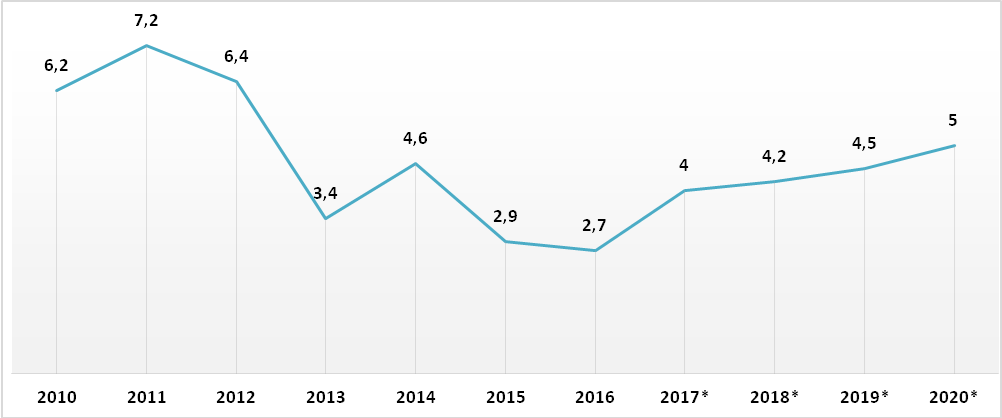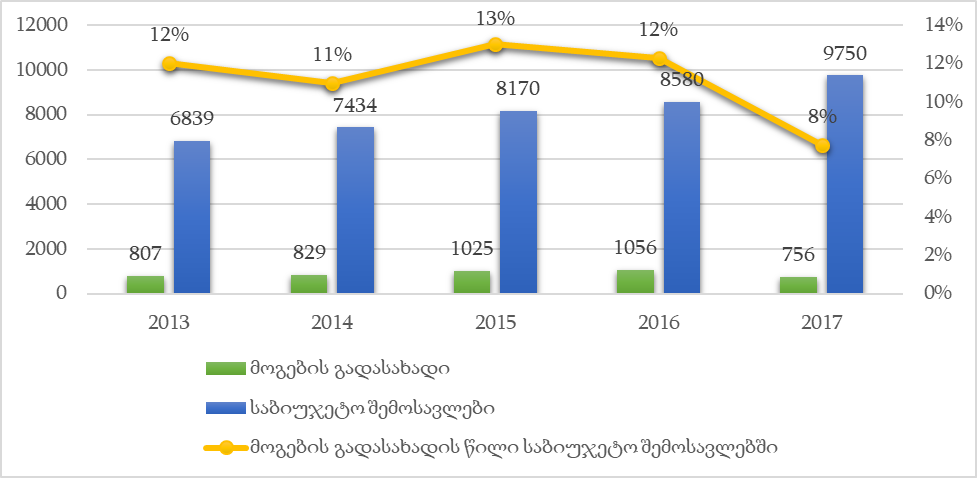The Minister of Finance of Georgia, Mamuka Bakhtadze,stated that Georgia’s economic growth rate was 5% in 2017 which is twice as high as compared to Georgia’s neighbour countries. International Monetary Fund estimates put Georgia as the leader for the entire region (31 nations) for the next three years.
FactCheck took interest in the accuracy of Mamuka Bakhtadze’s statement.
Preliminary data indicate that Georgia’s economic growth rate was 4.8% in 2017. The economic growth rate in 2016 was 2.8%.
Graph 1: Georgia’s Economic Growth Rate, %
Note: *Preliminary data for 2017
The growth of exports (including tourism) and state investment expenses in 2017 positively affected the economic growth rate. Georgia’s export increased by 29% in 2017 as compared to the previous year following improved economic situations throughout the rest of the region. State investments increased by 20% in 2017 as compared to the previous year.
A look at the economic growth rates for the countries in our neighbourhood illustrates the following: Russia– Preliminary data for 2017 put Russia’s real GDP growth rate at 1.6%. Russia’s economy had been slowed in the previous years. Russia’s GDP contracted by 0.2% in 2016 and by 2.8% in 2015. Turkey– Turkey’s economic growth rate was 3.3% in 2016 with preliminary data for 2017 showing an increase in its GDP by 6.6%. Armenia– Preliminary data for 2017 show that Armenia’s GDP growth rate is 3.5% whilst it was 0.2% in 2016. Azerbaijan– Preliminary data show that Azerbaijan’s GDP contracted by 0.1% in 2017 and by 3.1% in 2016.
Evidently, similar to Georgia, our neighbour countries have also improved their economic performance as compared to the previous year. In spite of Georgia’s economic growth rate being 4.8%, this figure is twice as high as compared to Russia and Azerbaijan’s economic growth rate although we lag behind Turkey’s economic growth rate by 1.8 percentage points.
Of note is that the economic recession in Russia and Azerbaijan is largely stipulated by a sharp drop in oil prices starting in 2014. Oil prices had a tendency of growth beginning in 2017 which facilitated the improvement in Russia and Azerbaijan’s economic performance.
The second part of Mamuka Bakhtadze’s statement concerns estimates for economic growth for the next three years. The International Monetary Fund predicts that Georgia’s real GDP growth rate will be 4.2% in 2018, 4.5% in 2019 and 5% in 2020.
Graph 2: International Monetary Fund Prognosis for Georgia’s GDP Growth Rate

Note: Estimated figures
Mamuka Bakhtadze’s statement referred to 31 countries; FactCheck; however, uses the World Bank’s country grouping which incorporates 24 nations of Europe and Central Asia, including Georgia. The number of countries in this region is close to the figure given by the Minister. In order to verify the second part of the statement, it is necessary to compare the economic growth prognosis in these countries to that of Georgia.
The International Monetary Fund ranks Georgia fourth (4.2%) in the region’s 24 countries in terms of economic growth for this year. Georgia is outperformed by Turkmenistan (6.3%), Uzbekistan (6%) and Romania (4.4%). However, of note is that the GDP growth rates in Turkmenistan and Romania will decline in the next two years, as opposed to that of Georgia, whilst Uzbekistan’s will remain the same. Estimated figures for 2019 show Georgia to continue to be in the fourth position (4.5%) in the region, outperformed by Uzbekistan (6%), Kyrgyzstan (5.2%) and Turkmenistan (5.1%). The prognosis for 2020 sees a further improved position for Georgia among the region’s countries.
Table 1: International Monetary Fund Three-Year GDP Growth Rate Prognosis
| Country | 2018 | 2019 | 2020 | Average | |
| 1 | Uzbekistan | 6.00% | 6.00% | 6.00% | 6.00% |
| 2 | Turkmenistan | 6.30% | 5.10% | 5.00% | 5.47% |
| 3 | Kyrgyzstan | 3.80% | 5.20% | 5.00% | 4.67% |
| 4 | Georgia | 4.20% | 4.50% | 5.00% | 4.57% |
| 5 | Tajikistan | 4.00% | 4.00% | 4.00% | 4.00% |
| 6 | Romania | 4.40% | 3.80% | 3.30% | 3.83% |
| 7 | Albania | 3.70% | 3.80% | 3.90% | 3.80% |
| 8 | Moldova | 3.70% | 3.80% | 3.80% | 3.77% |
| 9 | Serbia | 3.50% | 3.50% | 4.00% | 3.67% |
| 10 | Kosovo[1] | 3.50% | 3.60% | 3.70% | 3.60% |
| 11 | Turkey | 3.50% | 3.50% | 3.50% | 3.50% |
| 12 | Ukraine | 3.20% | 3.50% | 3.70% | 3.47% |
| 13 | Macedonia | 3.20% | 3.40% | 3.60% | 3.40% |
| 14 | Poland | 3.30% | 3.00% | 2.80% | 3.03% |
| 15 | Armenia | 2.90% | 3.00% | 3.10% | 3.00% |
| 16 | Kazakhstan | 2.80% | 2.80% | 3.20% | 2.93% |
| 17 | Bulgaria | 3.20% | 2.90% | 2.70% | 2.93% |
| 18 | Hungary | 3.40% | 2.80% | 2.60% | 2.93% |
| 19 | Bosnia and Herzegovina | 2.60% | 2.70% | 2.70% | 2.67% |
| 20 | Montenegro | 2.80% | 2.70% | 2.20% | 2.57% |
| 21 | Croatia | 2.70% | 2.50% | 2.30% | 2.50% |
| 22 | Azerbaijan | 1.30% | 3.00% | 2.60% | 2.30% |
| 23 | Russia | 1.60% | 1.50% | 1.50% | 1.53% |
| 24 | Belarus | 0.70% | 0.90% | 1.60% | 1.07% |
Conclusion
Preliminary data indicate that Georgia’s economic growth rate for 2017 was 4.8%. This figure lags behind Turkey’s economic growth rate by 1.8 percentage points and exceeds Armenia’s economic growth rate by 1.3 percentage points. Georgia’s economic growth rate is twice as much as compared to Azerbaijan and Russia’s economic growth rate. The sluggish economic growth in these countries is stipulated by a drop in oil prices and sanctions imposed against Russia.
Of the World Bank’s country groups, Georgia is located among the 24 nations of Europe and Central Asia. The International Monetary Fund’s three-year economic growth prognosis places Georgia in the fourth place among this grouping’s 24 countries. Based on average economic growth rate figures for the last three years, Georgia is outperformed by Uzbekistan, Turkmenistan and Kyrgyzstan.
FactCheck concludes that Mamuka Bakhtadze’s statement is MOSTLY FALSE.
[1]Georgia does not recognise the independence of Kosovo.

![In the previous year, Georgia’s economic growth rate was 5%. This is twice as high as compared to [countries in] our neighbourhood](https://www.factcheck.ge/storage/defaults/default-seo.jpeg)







